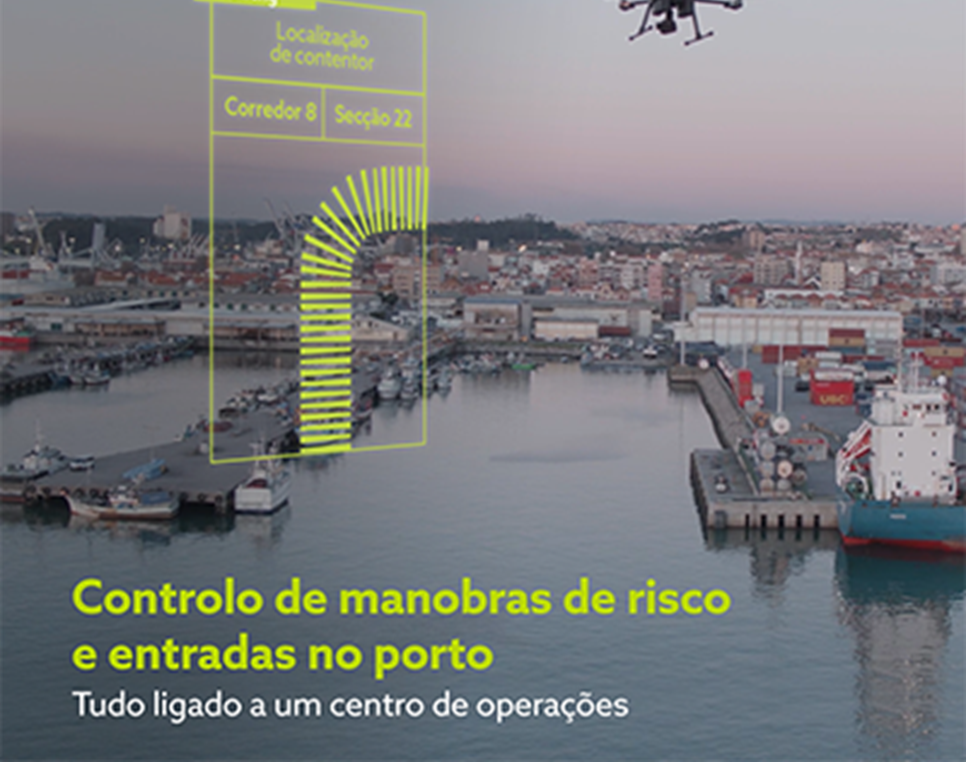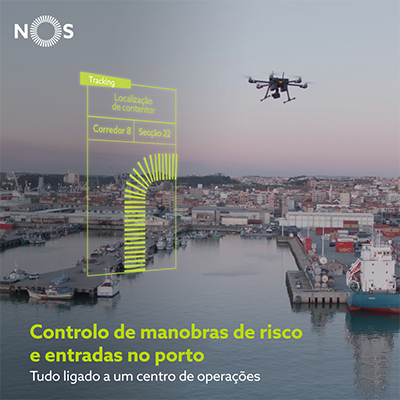A cornerstone of the national economy, Leixões Port is undergoing modernisation and embracing 5G to navigate through more technologically advanced and secure waters. A success story where state-of-the-art drones dock.
5G: A Sea of Opportunities for Leixões Port
Nearly 90% of global trade takes place via maritime transport, according to the International Chamber of Shipping (ICS).
Hence, it is widely agreed that ports constitute a fundamental pillar in the economies of countries. Portugal is no exception.
National ports, serving as transportation hubs, energy centers, industrial hubs, and part of the "blue economy," add value to the Portuguese economy and society at large, ensuring prosperity.

In an increasingly competitive and globalized context, ports are adapting to the new market demands to respond as effectively as their competitors and keep pace with the technological evolution of the industry itself. Developing and modernizing infrastructure, offering competitive logistics platforms, and investing in digitization and decarbonization to optimize maritime transportation, maximize employment in the sector, and increase exports are some examples of how ports worldwide have been evolving to face the future.
Porto de Leixões: A Success Story in the National Economy
In 2020, despite the pandemic's impact, Porto de Leixões handled over 17 million tons, reaching a new historic high of 703,919 TEUs (twenty-foot equivalent units), growing by 2.6% compared to 2019. This not only suggests resilience among importing and exporting companies operating within its influence area but also the port ecosystem's ability to quickly adapt to changing market conditions. Leixões is the country's leading exporter of containerized cargo and contributes to 7% of employment in Portugal and 6% of the national GDP.
This growth has been accompanied by ongoing efforts to modernize the port, both in terms of infrastructure intervention and digitization, with notable projects and the use of technologies such as:
The implementation of the Single Window Project for Leixões (3PL), employing computer vision technologies to automate its cargo entry and exit processes.
The development of the Integrated Logistics Single Window Platform (JUL), in collaboration with other national ports, which updates and extends the Port Single Window (JUP) to the entire national logistics chain, integrating with land transport, dry ports, and logistics platforms in an intermodal logic.
The APDL's simulation center - Administração dos Portos do Douro, Leixões e Viana do Castelo - equipped with the latest simulation equipment for maritime, river, and land operations, including Full Mission Bridge Simulators and Land Equipment Simulators, allowing professionals to train in realistic scenarios.
The development of a digital twin to monitor and manage the risk of dangerous cargo.
As Hugo Bastos, APDL's director of information systems, states, "Technology is already fundamental in supporting port business. However, we are witnessing a digital transformation, where, similar to other industries and businesses, the introduction of new potentially disruptive digital technologies is radically changing ports." Bastos specifically mentions 5G, Blockchain, IoT, Smart Sensing, Big Data, Analytics, AI (Machine Learning/Deep Learning), simulation, among other technologies, which are "about to radically change how ports operate, how they become more efficient, greener, and how they integrate into logistics chains."
Riding on the wave of the country's first 5G city in Matosinhos, created by NOS in 2019, Porto de Leixões is also part of the Technological Free Zone of this 5G mobile network pilot project in Portugal, which also includes other areas of this municipality. In a partnership between NOS and APDL, Porto de Leixões is turning another page in the digital transformation of national maritime ports, with the introduction of drones connected via 5G technology. This technology allows the manipulation of these drones remotely and in real-time, transmitting high-definition images to the command and control room of Porto de Leixões. This is a technological solution that will play a significant role in this port in terms of security, costs, efficiency, and predictability.
Through functionalities enabled by the fifth-generation network, 5G supports automation and inspection actions, promoting and improving the quality of detections and their corresponding data capture for future improvements analysis. Also, through intelligent automatic detection systems and high-resolution videos with automated identification of intruders on APDL's premises, with immediate transmission of this information to security personnel, 5G will make Porto de Leixões a much safer location.
The flight path of the drone can be pre-configured or dynamic, utilizing computer vision and real-time transmission. The devices can be controlled through a control center on-site or remotely by an operator who detects or suspects an anomaly, or through a quality control schedule. With hyperconnected networks at Porto de Leixões, operations and security can be greatly improved, as well as environmental aspects such as real-time monitoring of air and noise quality.
"In summary, technologies are changing ports, making them more sustainable both economically, as they become more integrated into intelligent logistics chains, faster, smoother, more predictable, agile, safer, and with lower costs, and environmentally, as they become greener, heading towards decarbonization and towards a green logistics network," concluded Hugo Bastos.
Once again, 5G emerges as a fundamental response to the Industry 4.0 paradigm. This pilot project at Porto de Leixões, implemented from scratch by NOS, is just another step towards the technological era in logistics networks, built upon a digital architecture with foundations of security, flexibility, efficiency, reliability, cost reduction, and sustainability. An innovative endeavor that arises in the present with an eye on the future, yet another example of a country that does what no one else has done.



